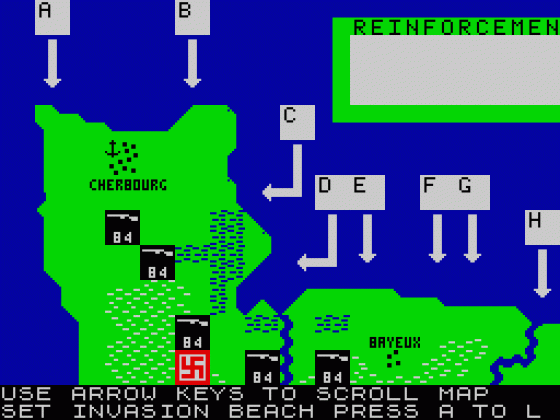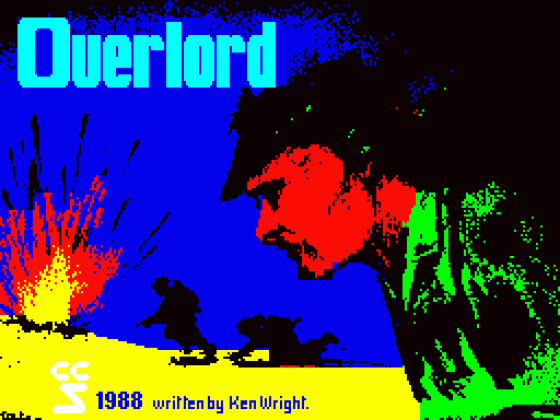Overlord
This is the second game that I've reviewed in FRONTLINE which deals with the famous Normandy landings, and last year I dealt with a Commodore game in ZZAP! on exactly the same subject. It seems that the Overlord campaign, when the Allied forces swept across the north coast of France in a well planned but not often well coordinated effort to liberate Europe, captures the imagination of wargame designers. It was the largest amphibious assault in history, it was the turning-point of the war that means most to us today, and the dramatic nature of events make it a perfect template for any wargame.
The campaign had been in planning for over a year, and was launched with five amphibious forces - assigned to their own landing beaches - backed up by three airborne divisions. It was two members of that airborne division who first touched occupied soil, at sixteen minutes past midnight on 6th June 1944. Their plane landed so abruptly that they were both catapulted forward out of the cockpit. This first contact was rapidly followed by waves of troops flooding onto the beaches. The American divisions found themselves scattered and uncoordinated; unable to concentrate their attack force at any one point they ended up fighting haphazardly wherever they met resistance. Ironically this disorganisation probably contributed to the success of the assault. The enemy was unprepared and confused, and was unable to discern any pattern in the landings simply because there wasn't one!
By contrast, the landing of the British 6th Airborne Division between the Orne and Dives rivers came off perfectly, and they achieved their pre-planned objectives within minutes. This, of course, was the scenario concentrated upon in Pegasus Bridge. More ambitiously, Overlord attempts to recreate the entire sweep of the campaign.

Overlord comes from Ken Wright, who now has Waterloo, Yankee and Blitzkrieg to his credit. Whereas the first of these two games are battle simulations, both Blitzkrieg and Overlord take a long-range overview of a whole campaign, complementing each other thematically. Blitzkrieg was based on the first sweep of the Axis armies into Europe, and Overlord lakes up the counter-attack.
The most fundamental question about Overlord is whether the scale chosen is correct for this kind of campaign. The Normandy landings were tightly-packed, individualistic events, and recreating them really requires attention to detail and a degree of precision. In Overlord, we have divisions represented by the usual square counters bearing slightly dubious symbols to identify them. In the context of these battles, they seem large and clumsy and are, by design, almost impossible to manipulate.
The on-screen appearance of the game is identical to that of Blitzkrieg and indeed the author's earlier games. A clear, though rather sparse map fills the screen without extraneous clutter, and all communication takes place in the small message strip at the bottom. One innovation is the reinforcement box: a panel which floats in the English Channel and allows the player access to the units of each of the seven armies which have not yet entered the game. The area represented is the northern coast of France, not unnaturally, but the map goes southwards for quite a bit further than I imagine it is generally possible to move your units. The whole map is seven times larger than the screen (according to the rulebook) and scrolls smoothly by means of the cursor keys.

The player has command of seven armies: five American corps, plus British and Canadian forces. The division types are divided into infantry, mechanised and armoured units, and each corps has seven units. There are also airborne divisions, which are few in number and function as normal infantry when they've made their landing.
These units are defined only by a morale rating and a percentage strength. They do not even have individual designations, though which tends to make them seem bland and somewhat anonymous. The way that the movement system works makes it impossible to place them precisely, however, so a certain interchangeability is useful.
After selecting a difficulty level from one to three (the morale of your units is affected by the choice) the game begins without further preamble. Due to memory restrictions, and the large amount of the program dedicated to driving the enemy ' s artificial intelligence routine, there is no choice of sides or option for a two-player game.

The turn structure, as in Blitzkrieg is divided into a single orders phase and a sit-back-and watch execution phase. At the start of the game, however, all the player's units are floating in some nebulous region to the north of the map. The continent is occupied only by enemy units which, although they disappear into a fog of limited intelligence after the first turn, are clustered in full and frighteningly prolific view. The invasion must in initiated on the first turn, and to this end the first thing the player does is to 'activate' five beaches to land on from a choice of twelve. The beaches are effectively points on the northern coastline where units can be brought onto the map, and are lettered A to L. Further beaches can be activated by moving units close to them.
On the first turn only infantry units can be mobilised, and only one can land on each beach. This means that the strategic decisions possible on the first turn are limited to the choice of landing areas-not unimportant - and of the corps to be used in the first assault. On the action phase of the first turn, the chosen units are moved onto the beaches. The thing to do in the next turn is to get them off them as soon as possible, so that others can be moved in. On the first turn there is also an airborne units option, if a corps with such units has been chosen for the initial assault. The airborne unit can form a spearhead by landing up to three squares away from one of the active beaches.
The movement orders are entered in much the same way as in Blitzkrieg the general line of advance of the corps is set by a central, right and left flank position; it is not possible to give orders to individual units. Combat orders are limited to a choice of three approaches: whether to attack any enemy unit that they might encounter, not to engage in combat at all, or to attack when the general thinks there is a good chance of success. Once these orders are entered for each army, the execution phase moves the units in some approximation to your intentions and then resolves combat in a leisurely and intelligible way.
In combat, mechanised and armoured units have the advantage, and units with a low morale are seriously at a disadvantage. Terrain has its effect too, though it is not possible to use terrain to the same advantage as one could in the author's smaller-scale games. In fact, the impossibility of positioning units precisely makes it difficult to care much about this aspect. The results of combat, instantaneously displayed, are somewhat monotonous: strength, or effectiveness, is chipped off units in 5% blocks. I have never seen damage greater than 20% in one combat round, although in a single combat phase a unit might suffer considerable damage from repeated attack by enemy units surrounding it.
The author lays great emphasis on the artificial intelligence driving the enemy, but the first thing this routine is called upon to simulate is confusion as the enemy dots about helplessly in response to the unexpected invasion. But they soon rally and come streaming up to the beaches in alarmingly large and solid numbers. The first stage of the game is very much about the problem of getting sufficient numbers of units onto the map before the enemy closes in and makes it difficult to move units off the beaches. Quick inland movement is essential, but going too far is dangerous because the units get trapped amongst the encroaching Germans. The ideal is to build up a solid defensive wall along the coast, with more than the initial five beaches activated and all units in play. Then the player can meet the German army on equal terms, wear it down, and start to advance.
The difficulty is that the movement system makes it hard to manipulate the units into doing anything sensible. The lack of control over movement - unique in the Spectrum wargaming world to Ken Wright's games - is interesting and unusual in its proper application, but frustrating in this scenario. It is true that most of the divisions landed in disorder, but the simulation - if it is supposed to be a simulation of that aspect - has very little reality.
There are no specific victory conditions to strive for: play is stopped if either army falls before 40% effectiveness, if Allied units reach the right hand edge of the map, or if all become deactivated. Victory for either side is decided purely on the respective strengths of each army at the time of play ceasing, which is infuriatingly artificial. It is much more satisfactory to have structured goals in this type of game, especially when it aims, as this one does, for sophistication.
Despite these negative aspects, the potential for varied development of strategy is very great and this is certainly an extremely well designed and well presented wargame. I would have no hesitation in recommending it's a purchase and I'm looking forward to the next offering from the same keyboard.


 1st April 1988
1st April 1988











